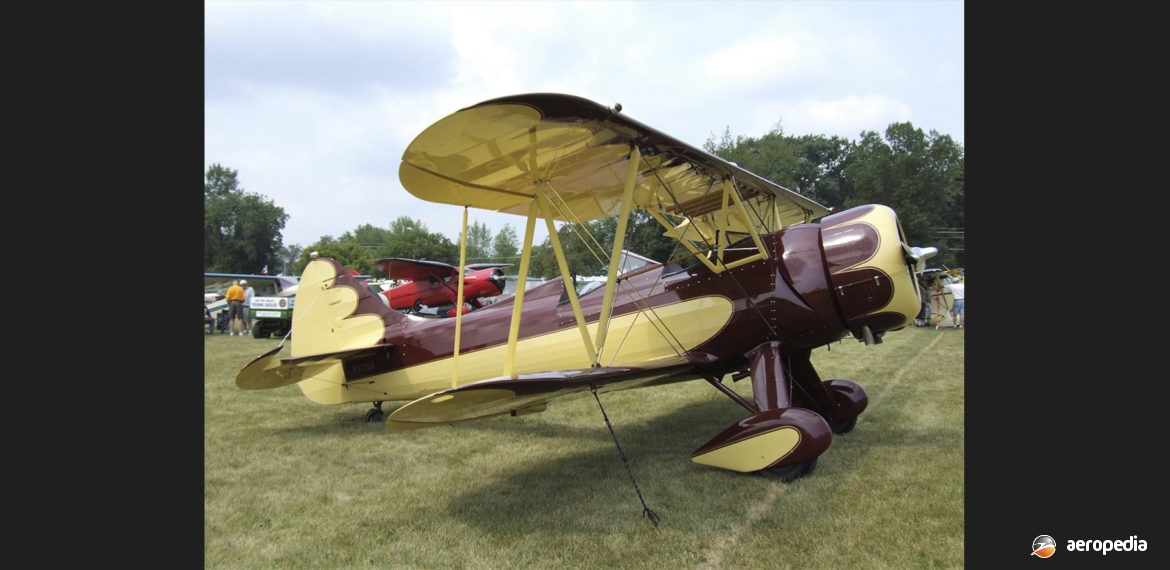Photograph:
Waco UPF-7 N3215B at Oshkosh, Wisconsin, USA in 2007 (David C Eyre)
Country of origin:
United States of America
Description:
Three-seat sport biplane
Power Plant:
One 164 kw (220 hp) Continental W670K seven-cylinder air-cooled radial engine
Specifications:
- Wingspan [upper]: 9.14 m (30 ft)
- Wingspan [lower]: 8.2 m (26 ft 10 in)
- Length: 7.16 m (23 ft 6 in)
- Height: 2.59 m (8 ft 6 in)
- Wing area: 22.63 m² (243.6 sq ft)
- Max speed at sea level: 209 km/h (130 mph)
- Cruising speed at 75% power: 185 km/h (115 mph)
- Landing speed: 80 km/h (50 mph)
- Initial rate of climb at sea level: 274 m/min (900 ft/min)
- Time to 2,743 m (9,000 ft): 15 mins
- Service ceiling: 4,511 m (14,800 ft)
- Fuel capacity: 189 litres (41.6 Imp gals)
- Cruising range: 644 km (400 miles)
- Empty weight: 848 kg (1,870 lb)
- Useful load: 354 kg (780 lb)
- Loaded weight: 1,202 kg (2,650 lb)
History:
In November 1935 the Waco YPF-6 was certificated (ATC-586) in the United States. Seating three, with the pilot under a hood in the rear cockpit, it could be fitted with either the 168 kw (225 hp) Jacobs LA-1 engine or the 213 kw (285 hp) Jacobs L-5 engine in the ZPF-6. The front cockpit could be covered when not in use.
In 1937 the YPF-7 and ZPF-7 appeared, followed by the VPF-7 which was for the Army of Guatemala and had a 179 kw (240 hp) Continental R-670 radial engine. These models led to the very popular UPF-7 trainer which was tested by the USAAC, one being obtained in February 1939 with a 164 kw (220 hp) Continental W-670-6A engine. The Type Certificate was issued on 5 June 1937 and covered the UPF-7 and VPF-7 models.
The US Army required a number of modifications and, following this, it became known initially as the XPT-14 during testing, and was followed by 13 examples of the YPT-14 in September 1939.
The UPF-7 had a wider undercarriage and full engine cowlings; although quite often these were removed to aid quick servicing. Production aircraft for civil operators did not have cowlings, most of these destined for the Civil Pilot Training Programme which had been set up in June 1939 to train pilots as the world was getting close to war. Three were supplied to Venezuela in 1940. Some 575 were built for the civil programme and some 140 of these are believed to survive.
In service with the USAAC it was known as the PT-14, eleven being transferred to the Civil Aeronautics Authority in 1944, which later received a further 34 for its private-flying section, one being allocated to each Government Inspector to monitor civil operations in his district. Whilst the UPF-7 was in production the US entered World War II and Waco joined the American war effort, producing a series of large assault gliders, particularly for the invasion of Europe in June 1944.
The fuselage of the UPF-7 was welded steel tube, faired to shape and then fabric covered. The wing had solid spruce spar beams with spruce truss-type wing, ribs being reinforced with mahogany plywood gussets. The leading-edges of the wing were covered with sheet metal and the completed framework was covered with fabric. It could be fitted with either the 179 kw (240 hp) Continental W670K or W670-6A engine.
The UPF-7 was described as being ”able to take on many and varied assignments and perform them all with confidence…was manoeuvrable, predictable, and very capable. Its flight characteristics were excellent with good control, it was nimble enough for most aerobatics and, like all Waco biplanes, it was a pleasure to fly”. It was said in the 1960s that the UPF-7 was just about the most popular sport type airplane in America.
In April 1992 a Waco UPF-7 (c/n 5687 – ex NC32056) was imported from the United States by Rob Poynton of Gooseberry Hill, WA, the registration being allotted on 28 April 1992 as VH-IOI. It was changed on 18 November 1997 to VH-NVF to Panama Jacks of Kalamanda, WA but its restoration was never completed and it was exported to Memphis, Tennesee in August 2019 as N8749X

